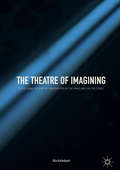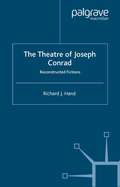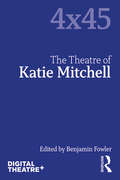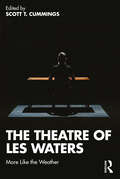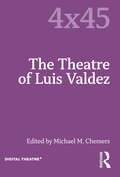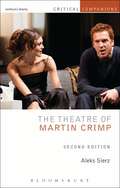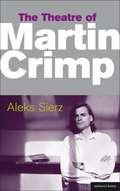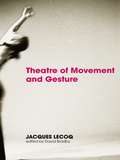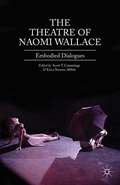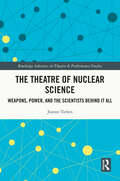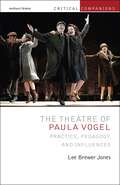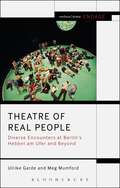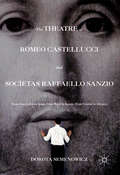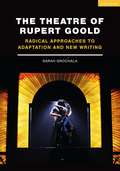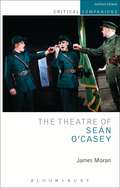- Table View
- List View
The Theatre of Imagining: A Cultural History of Imagination in the Mind and on the Stage
by Ulla KallenbachThis book is the first comprehensive analysis of the fascinating and strikingly diverse history of imagination in the context of theatre and drama. Key questions that the book explores are: How do spectators engage with the drama in performance, and how does the historical context influence the dramaturgy of imagination? In addition to offering a study of the cultural history and theory of imagination in a European context including its philosophical, physiological, cultural and political implications, the book examines the cultural enactment of imagination in the drama text and offers practical strategies for analyzing the aesthetic practice of imagination in drama texts. It covers the early modern to the late modernist period and includes three in-depth case studies: William Shakespeare’s Macbeth (c.1606); Henrik Ibsen’s A Doll’s House (1879); and Eugène Ionesco’s The Killer (1957).
The Theatre of Imagining: A Cultural History of Imagination in the Mind and on the Stage
by Ulla KallenbachThis book is the first comprehensive analysis of the fascinating and strikingly diverse history of imagination in the context of theatre and drama. Key questions that the book explores are: How do spectators engage with the drama in performance, and how does the historical context influence the dramaturgy of imagination? In addition to offering a study of the cultural history and theory of imagination in a European context including its philosophical, physiological, cultural and political implications, the book examines the cultural enactment of imagination in the drama text and offers practical strategies for analyzing the aesthetic practice of imagination in drama texts. It covers the early modern to the late modernist period and includes three in-depth case studies: William Shakespeare’s Macbeth (c.1606); Henrik Ibsen’s A Doll’s House (1879); and Eugène Ionesco’s The Killer (1957).
The Theatre of Joseph Conrad: Reconstructed Fictions
by Richard J. HandAlthough the dramatic dimension to Joseph Conrad's fiction is frequently acknowledged, his own experiments in drama have traditionally been marginalized. However, in all of Conrad's plays we see a distinct effort to investigate seriously the dramatic form and some of his plays are startlingly ahead of their time. Furthermore, all of the plays are adaptations and comprise One Day More , based on Tomorrow , Laughing Anne , based on Because of the Dollars, Victory: A Drama and The Secret Agent . The creation of these reveals much about the history, theory and practice of this fascinating cultural process.
The Theatre of Katie Mitchell (4x45)
by Benjamin FowlerThis first volume in the 4x45 series investigates the work of theatre director Katie Mitchell. Pausing to reconsider a career in progress, it engages with some of Mitchell’s most recent work in the UK and Europe across theatre, opera, and Live Cinema. It also takes a longer view, considering the early turns that Mitchell took at the start of her career in the late 1980s. This volume gives full scope to the voice of the practitioner, alongside scholarly perspectives, in order to understand the work from within. Interviews with Mitchell’s collaborators get inside her process – and inside the thinking of key artists who help craft the distinctive visual, aesthetic and technological forms of Mitchell’s productions. Three major concerns criss-cross these contributions: the political implications of aesthetic form; the meaning of Mitchell’s interest in the radical project of early Naturalism; and the influence of Europe on Mitchell’s avant-garde experimentalism, which often draws on technology to open up new modes of perception and experience. An accessible and encompassing examination of one of Europe's most celebrated theatrical talents, 4x45 | The Theatre of Katie Mitchell is a unique resource for scholars,students and practitioners of Theatre Studies, Performance and Directing.
The Theatre of Katie Mitchell (4x45)
by Benjamin FowlerThis first volume in the 4x45 series investigates the work of theatre director Katie Mitchell. Pausing to reconsider a career in progress, it engages with some of Mitchell’s most recent work in the UK and Europe across theatre, opera, and Live Cinema. It also takes a longer view, considering the early turns that Mitchell took at the start of her career in the late 1980s. This volume gives full scope to the voice of the practitioner, alongside scholarly perspectives, in order to understand the work from within. Interviews with Mitchell’s collaborators get inside her process – and inside the thinking of key artists who help craft the distinctive visual, aesthetic and technological forms of Mitchell’s productions. Three major concerns criss-cross these contributions: the political implications of aesthetic form; the meaning of Mitchell’s interest in the radical project of early Naturalism; and the influence of Europe on Mitchell’s avant-garde experimentalism, which often draws on technology to open up new modes of perception and experience. An accessible and encompassing examination of one of Europe's most celebrated theatrical talents, 4x45 | The Theatre of Katie Mitchell is a unique resource for scholars,students and practitioners of Theatre Studies, Performance and Directing.
The Theatre of Les Waters: More Like the Weather
by Scott T. CummingsThe Theatre of Les Waters: More Like the Weather combines original writings from Les Waters with short essays by a wide range of his collaborators, creating a personal and multi-faceted portrait of an influential director, revered mentor, and inspirational theatre artist. The book begins with a critical introduction of Waters’s work, followed by essays written by a wide range of Waters's collaborators over the past four decades. These essays are framed by shorter pieces of writing by Waters himself: reflections, inspirations, observations, and personal anecdotes. At the heart of this book lies the notion that the director’s central position in theatrical production is defined by collaboration and that a study of directing should take into account how a director works with playwrights, designers, actors, stage managers, and dramaturgs to turn artistic vision into concrete reality on stage. An insightful resource for early career or student directors in theatre programs, The Theatre of Les Waters sheds light on the art of theatre directing by exploring the work of a major theatre artist whose accomplished career sits at the heart of American theatre in the 21st century. Drawing on aspects of memoir, case study, interview, miscellany, biography, and criticism, this is also an enlightening read for anyone with an interest in how theatre artists bring their creative vision to life.
The Theatre of Les Waters: More Like the Weather
by Scott T. CummingsThe Theatre of Les Waters: More Like the Weather combines original writings from Les Waters with short essays by a wide range of his collaborators, creating a personal and multi-faceted portrait of an influential director, revered mentor, and inspirational theatre artist. The book begins with a critical introduction of Waters’s work, followed by essays written by a wide range of Waters's collaborators over the past four decades. These essays are framed by shorter pieces of writing by Waters himself: reflections, inspirations, observations, and personal anecdotes. At the heart of this book lies the notion that the director’s central position in theatrical production is defined by collaboration and that a study of directing should take into account how a director works with playwrights, designers, actors, stage managers, and dramaturgs to turn artistic vision into concrete reality on stage. An insightful resource for early career or student directors in theatre programs, The Theatre of Les Waters sheds light on the art of theatre directing by exploring the work of a major theatre artist whose accomplished career sits at the heart of American theatre in the 21st century. Drawing on aspects of memoir, case study, interview, miscellany, biography, and criticism, this is also an enlightening read for anyone with an interest in how theatre artists bring their creative vision to life.
The Theatre of Luis Valdez (4x45)
by Michael M. ChemersThe Theatre of Luis Valdez focuses on the life and work of American playwright and director Luis Valdez, probably best known for his landmark 1979 play Zoot Suit – the first play by a Latinx playwright to appear on Broadway – and founder of El Teatro Campesino, the oldest surviving community theatre in the United States. Built around first-hand discussions of Valdez’s work, this collection gives an in-depth understanding of where ‘the godfather of Chicano theatre’ fits in the grand scheme of American drama and performance. Collaborators Edward James Olmos and Alma Martinez talk about working with Valdez and El Teatro Campesino; scholar Leticia Garcia interviews Jorge Huerta, the leading authority on Chicanx and Latinx theatre on the impact of Valdez work; and Luis Valdez himself contributes a lecture on all aspects of his craft from political resistance and the migrant experience to actor training and dramatic form. A concise and accessible study, 4x45 || Luis Valdez is the go-to resource for scholars, students and theatre practitioners looking for an introduction to this seminal figure in modern American performance.
The Theatre of Luis Valdez (4x45)
by Michael M. ChemersThe Theatre of Luis Valdez focuses on the life and work of American playwright and director Luis Valdez, probably best known for his landmark 1979 play Zoot Suit – the first play by a Latinx playwright to appear on Broadway – and founder of El Teatro Campesino, the oldest surviving community theatre in the United States. Built around first-hand discussions of Valdez’s work, this collection gives an in-depth understanding of where ‘the godfather of Chicano theatre’ fits in the grand scheme of American drama and performance. Collaborators Edward James Olmos and Alma Martinez talk about working with Valdez and El Teatro Campesino; scholar Leticia Garcia interviews Jorge Huerta, the leading authority on Chicanx and Latinx theatre on the impact of Valdez work; and Luis Valdez himself contributes a lecture on all aspects of his craft from political resistance and the migrant experience to actor training and dramatic form. A concise and accessible study, 4x45 || Luis Valdez is the go-to resource for scholars, students and theatre practitioners looking for an introduction to this seminal figure in modern American performance.
The Theatre of Martin Crimp: Second Edition (Critical Companions)
by Aleks SierzFirst published in 2006, Alek's Sierz's The Theatre of Martin Crimp provided a groundbreaking study of one of British theatre's leading contemporary playwrights. Combining Sierz's lucid prose and sharp analysis together with interviews with Martin Crimp and a host of directors and actors who have produced the work, it offered a richly rewarding and engaging assessment of this acutely satirical playwright. The second edition additionally explores the work produced between 2006 and 2013, both the major new plays and the translations and other work. The second edition considers The City, the 2008 companion play to The Country, Play House from 2012 and the new work for the Royal Court in late 2012. The two works that have brought Crimp considerable international acclaim in recent years, the updated rewrite of The Misanthrope which in 2009 played for several months in the West End starring Keira Knightley, and Crimp's translation of Botho Strauss's Big and Small (Barbican, 2012), together with Crimp's other work in translation are all covered. The Theatre of Martin Crimp remains the fullest, most readable account of Crimps's work for the stage.
The Theatre of Martin Crimp: Second Edition (Critical Companions)
by Aleks SierzFirst published in 2006, Alek's Sierz's The Theatre of Martin Crimp provided a groundbreaking study of one of British theatre's leading contemporary playwrights. Combining Sierz's lucid prose and sharp analysis together with interviews with Martin Crimp and a host of directors and actors who have produced the work, it offered a richly rewarding and engaging assessment of this acutely satirical playwright. The second edition additionally explores the work produced between 2006 and 2013, both the major new plays and the translations and other work. The second edition considers The City, the 2008 companion play to The Country, Play House from 2012 and the new work for the Royal Court in late 2012. The two works that have brought Crimp considerable international acclaim in recent years, the updated rewrite of The Misanthrope which in 2009 played for several months in the West End starring Keira Knightley, and Crimp's translation of Botho Strauss's Big and Small (Barbican, 2012), together with Crimp's other work in translation are all covered. The Theatre of Martin Crimp remains the fullest, most readable account of Crimps's work for the stage.
The Theatre of Martin Crimp epub: Second Edition (Critical Companions)
by Aleks SierzA guide to all of the plays of Martin Crimp. For a decade, Martin Crimp has been in the vanguard of new writing for the British stage. His main stage plays include Dealing with Clair, The Treatment, Attempts on Her Life, The Country, and Cruel and Tender, with his 1997 masterpiece, Attempts on Her Life,arguably being one of the best plays of the past quarter century. Bythe author of the landmark study of contemporary British drama, In-Yer-Face Theatre, this is the first study of Martin Crimp's work for stage and radio. Arguing that Crimp is one of the most acute satirists of contemporary British society, Aleks Sierz provides an accessible and fascinating account of the playwright's work.As well as an account of each of Crimp's plays and an analysis of hisoeuvre, the volume includes a wide-ranging interview with Crimp himselfand interviews with all the key directors responsible for staging hiswork, including Sam Walters, Katie Mitchell, James Mcdonald and LindsayPosner.
Theatre of Movement and Gesture
by Jacques LecoqPublished in France in 1987, this is the book in which Lecoq first set out his philosophy of human movement, and the way it takes expressive form in a wide range of different performance traditions. He traces the history of pantomime, sets out his definition of the components of the art of mime, and discusses the explosion of physical theatre in the second half of the twentieth century. Interviews with major theatre practitioners Ariane Mnouchkine and Jean-Louis Barrault by Jean Perret, together with chapters by Perret on Étienne Decroux and Marcel Marceau, fill out the historical material written by Lecoq, and a final section by Alain Gautré celebrates the many physical theatre practitioners working in the 1980s.
Theatre of Movement and Gesture
by Jacques LecoqPublished in France in 1987, this is the book in which Lecoq first set out his philosophy of human movement, and the way it takes expressive form in a wide range of different performance traditions. He traces the history of pantomime, sets out his definition of the components of the art of mime, and discusses the explosion of physical theatre in the second half of the twentieth century. Interviews with major theatre practitioners Ariane Mnouchkine and Jean-Louis Barrault by Jean Perret, together with chapters by Perret on Étienne Decroux and Marcel Marceau, fill out the historical material written by Lecoq, and a final section by Alain Gautré celebrates the many physical theatre practitioners working in the 1980s.
The Theatre of Naomi Wallace: Embodied Dialogues
by Scott T. Cummings Erica Stevens AbbittNaomi Wallace, an American playwright based in Britain, is one of the more original and provocative voices in contemporary theatre. Her poetic, erotically-charged, and politically engaged plays have been seen in London's West End, off-Broadway, at the Comédie-Française, in regional and provincial theaters, and on college campuses around the world. Known for their intimate, sensual encounters examining the relationship between identity and power, Wallace's works have attracted a wide range of theatre practitioners, including such important directors as Dominic Dromgoole, Ron Daniels, Jo Bonney, and Kwame Kwei-Armah. Drawing on scholars, activists, historians, and theatre artists in the United States, Canada, Britain, and the Middle East, this anthology of essays presents a comprehensive overview of Wallace's body of work that will be of use to theatre practitioners, students, scholars, and educators alike.
The Theatre of Nuclear Science: Weapons, Power, and the Scientists Behind it All (Routledge Advances in Theatre & Performance Studies)
by Jeanne P TiehenThe Theatre of Nuclear Science theoretically explores theatrical representations of nuclear science to reconsider a science that can have consequences beyond imagination. Focusing on a series of nuclear science plays that span the twentieth and twenty-first centuries, and including performances of nuclear science in museums, film, and media, Jeanne Tiehen argues why theatre and its unique qualities can offer important perspectives on this imperative topic. This book will be of great interest to students and scholars of theatre, politics, and literature.
The Theatre of Nuclear Science: Weapons, Power, and the Scientists Behind it All (Routledge Advances in Theatre & Performance Studies)
by Jeanne P TiehenThe Theatre of Nuclear Science theoretically explores theatrical representations of nuclear science to reconsider a science that can have consequences beyond imagination. Focusing on a series of nuclear science plays that span the twentieth and twenty-first centuries, and including performances of nuclear science in museums, film, and media, Jeanne Tiehen argues why theatre and its unique qualities can offer important perspectives on this imperative topic. This book will be of great interest to students and scholars of theatre, politics, and literature.
The Theatre of Paula Vogel: Practice, Pedagogy, and Influences (Critical Companions)
by Dr Lee Brewer JonesIn this volume, Lee Brewer Jones examines Paula Vogel as both a playwright and renowned teacher, analyzing texts and early reviews of Vogel's major plays-including Indecent, Desdemona, How I Learned to Drive, and The Baltimore Waltz-before turning attention to her influence upon other major American playwrights, including Sarah Ruhl, Lynn Nottage, and Quiara Alegría Hudes. Chapters explore Vogel's plays in chronological order, consider her early influences and offer detailed accounts of her work in performance. Enriched by an interview with Lynn Nottage and essays from scholars Ana Fernández-Caparrós and Amy Muse, this is a vibrant exploration of Paula Vogel as a major American playwright.By the time Paula Vogel made her Broadway debut with her 2017 Rebecca Taichman collaboration Indecent, she was already an accomplished playwright, with a Pulitzer Prize for How I Learned to Drive (1998) and two Obie Awards. She had also enjoyed a brilliant career as a professor at Brown and Yale with students such as Sarah Ruhl, a MacArthur “Genius” Grant winner, Pulitzer Prize winners Nilo Cruz, Quiara Alegría Hudes, and the only woman to win two Pulitzers for Drama, Lynn Nottage. Vogel's theatre draws upon Russian Formalist Viktor Shklovsky and uses devices such as “defamiliarization” and “negative empathy” to challenge conventional definitions of protagonists and antagonists.
Theatre of Real People: Diverse Encounters at Berlin’s Hebbel am Ufer and Beyond (Methuen Drama Engage)
by Ulrike Garde Meg MumfordTheatre of Real People offers fresh perspectives on the current fascination with putting people on stage who present aspects of their own lives and who are not usually trained actors. After providing a history of this mode of performance, and theoretical frameworks for its analysis, the book focuses on work developed by seminal practitioners at Berlin's Hebbel am Ufer (HAU) production house. It invites the reader to explore the HAU's innovative approach to Theatre of Real People, authenticity and cultural diversity during the period of Matthias Lilienthal's leadership (2003–12). Garde and Mumford also elucidate how Theatre of Real People can create and destabilise a sense of the authentic, and suggest how Authenticity-Effects can present new ways of perceiving diverse and unfamiliar people. Through a detailed analysis of key HAU productions such as Lilienthal's brainchild X-Apartments, Mobile Academy's Blackmarket, and Rimini Protokoll's 100% City, the book explores both the artistic agenda of an important European theatre institution, and a crucial aspect of contemporary theatre's social engagement.
Theatre of Real People: Diverse Encounters at Berlin’s Hebbel am Ufer and Beyond (Methuen Drama Engage)
by Ulrike Garde Meg MumfordTheatre of Real People offers fresh perspectives on the current fascination with putting people on stage who present aspects of their own lives and who are not usually trained actors. After providing a history of this mode of performance, and theoretical frameworks for its analysis, the book focuses on work developed by seminal practitioners at Berlin's Hebbel am Ufer (HAU) production house. It invites the reader to explore the HAU's innovative approach to Theatre of Real People, authenticity and cultural diversity during the period of Matthias Lilienthal's leadership (2003–12). Garde and Mumford also elucidate how Theatre of Real People can create and destabilise a sense of the authentic, and suggest how Authenticity-Effects can present new ways of perceiving diverse and unfamiliar people. Through a detailed analysis of key HAU productions such as Lilienthal's brainchild X-Apartments, Mobile Academy's Blackmarket, and Rimini Protokoll's 100% City, the book explores both the artistic agenda of an important European theatre institution, and a crucial aspect of contemporary theatre's social engagement.
The Theatre of Romeo Castellucci and Socìetas Raffaello Sanzio: From Icon to Iconoclasm, From Word to Image, From Symbol to Allegory
by Dorota SemenowiczThis book focuses on Romeo Castellucci’s theatrical project, exploring the ethical and aesthetic framework determined by his reflection on the nature of the image. But why does a director whose fundamental artistic tool is the image deny this key conceptual notion? Rooted in his conscious distancing from iconoclasm in the 1980s, Castellucci frequently replaces this notion with the words ‘symbol’, ‘form’ and ‘idea’.As the first publication on the international market which presents Castellucci’s work from both historical and theoretical perspectives, this book systematically confronts the director’s discourse with other concepts related to his artistic project. Capturing the evolution of his theatre from icon to iconoclasm, word to image and symbol to allegory, the book explores experimental notions of staging alongside an ‘emotional wave’, which serves as an animating principle of Castellucci’s revolutionary theatre.
The Theatre of Rupert Goold: Radical Approaches to Adaptation and New Writing (Critical Companions Ser.)
by Sarah GrochalaSince the late 1990s, Rupert Goold has garnered a reputation as one of the UK's most exciting and provocative theatre directors. His exhilarating, risk-taking productions of both classic texts and new plays have travelled from regional stages to the National Theatre, the West End, Broadway and beyond. Through his artistic directorship of Northampton's Royal & Derngate, the touring theatre company Headlong and London's Almeida Theatre, he has radically transformed, not only the companies themselves, but the landscape of British theatre. This is the first book to survey and analyse the full range of Goold's work to date and is a vital resource for students, scholars and fans of his work.Based on extensive interviews with Goold and some of the playwrights, designers, actors and other creatives who have collaborated with him, The Theatre of Rupert Goold provides an account of Goold's work from the beginnings of his career to the present day, offering a backstage view of the creative processes behind some of his most successful productions including: Paradise Lost, Faustus (Royal & Derngate); Macbeth (Chichester Festival Theatre); The Tempest, Romeo and Juliet (RSC); Six Characters in Search of an Author, ENRON (Headlong); Time and the Conways (National Theatre); Charles III and Ink (Almeida). The Theatre of Rupert Goold is an accessible and fascinating guide to Goold's approach to making theatre, an approach that asks provocative questions of the modern world in the most theatrical ways imaginable.
The Theatre of Rupert Goold: Radical Approaches to Adaptation and New Writing (Critical Companions Ser.)
by Sarah GrochalaSince the late 1990s, Rupert Goold has garnered a reputation as one of the UK's most exciting and provocative theatre directors. His exhilarating, risk-taking productions of both classic texts and new plays have travelled from regional stages to the National Theatre, the West End, Broadway and beyond. Through his artistic directorship of Northampton's Royal & Derngate, the touring theatre company Headlong and London's Almeida Theatre, he has radically transformed, not only the companies themselves, but the landscape of British theatre. This is the first book to survey and analyse the full range of Goold's work to date and is a vital resource for students, scholars and fans of his work.Based on extensive interviews with Goold and some of the playwrights, designers, actors and other creatives who have collaborated with him, The Theatre of Rupert Goold provides an account of Goold's work from the beginnings of his career to the present day, offering a backstage view of the creative processes behind some of his most successful productions including: Paradise Lost, Faustus (Royal & Derngate); Macbeth (Chichester Festival Theatre); The Tempest, Romeo and Juliet (RSC); Six Characters in Search of an Author, ENRON (Headlong); Time and the Conways (National Theatre); Charles III and Ink (Almeida). The Theatre of Rupert Goold is an accessible and fascinating guide to Goold's approach to making theatre, an approach that asks provocative questions of the modern world in the most theatrical ways imaginable.
The Theatre of Sean O'Casey (Critical Companions)
by James Moran Garry Hynes Paul Murphy Victor MerrimanThis Critical Companion to the work of one of Ireland's most famous and controversial playwrights, Sean O'Casey, is the first major study of the playwright's work to consider his oeuvre and the archival material that has appeared during the last decade. Published ahead of the centenary of the 1916 Easter Rising in Ireland with which O'Casey's most famous plays are associated, it provides a clear and detailed study of the work in context and performance.James Moran shows that O'Casey not only remains the most performed playwright at Ireland's national theatre, but that the playwright was also one of the most controversial and divisive literary figures, whose work caused riots and who alienated many of his supporters. Since the start of the 'Troubles' in the North of Ireland, his work has been associated with Irish historical revisionism, and has become the subject of debate about Irish nationalism and revolutionary history. Moran's admirably clear study considers the writer's plays, autobiographical writings and essays, paying special attention to the Dublin trilogy, The Shadow of a Gunman, Juno and the Paycock, and The Plough and the Stars. It considers the work produced in exile, during the war and the late plays. The Companion also features a number of interviews and essays by other leading scholars and practitioners, including Garry Hynes, Victor Merriman and Paul Murphy, which provide further critical perspectives on the work.
The Theatre of Sean O'Casey (Critical Companions)
by James Moran Garry Hynes Paul Murphy Victor MerrimanThis Critical Companion to the work of one of Ireland's most famous and controversial playwrights, Sean O'Casey, is the first major study of the playwright's work to consider his oeuvre and the archival material that has appeared during the last decade. Published ahead of the centenary of the 1916 Easter Rising in Ireland with which O'Casey's most famous plays are associated, it provides a clear and detailed study of the work in context and performance.James Moran shows that O'Casey not only remains the most performed playwright at Ireland's national theatre, but that the playwright was also one of the most controversial and divisive literary figures, whose work caused riots and who alienated many of his supporters. Since the start of the 'Troubles' in the North of Ireland, his work has been associated with Irish historical revisionism, and has become the subject of debate about Irish nationalism and revolutionary history. Moran's admirably clear study considers the writer's plays, autobiographical writings and essays, paying special attention to the Dublin trilogy, The Shadow of a Gunman, Juno and the Paycock, and The Plough and the Stars. It considers the work produced in exile, during the war and the late plays. The Companion also features a number of interviews and essays by other leading scholars and practitioners, including Garry Hynes, Victor Merriman and Paul Murphy, which provide further critical perspectives on the work.
